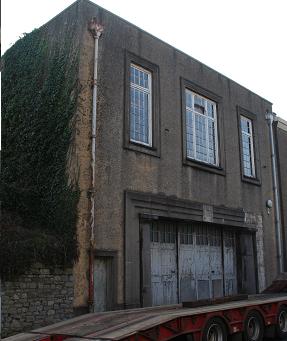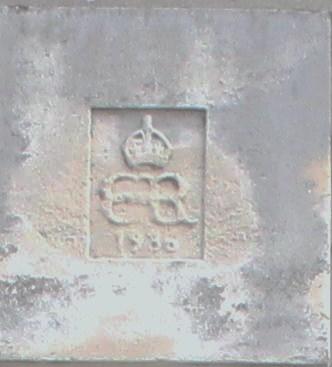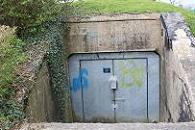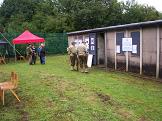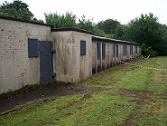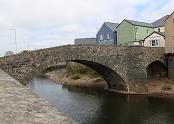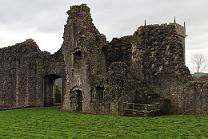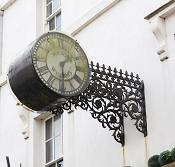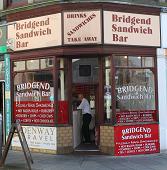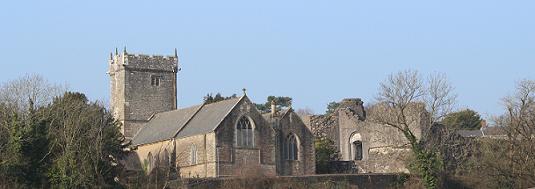 Bridgend
the town by the river
Bridgend
the town by the river
HMS Tudor
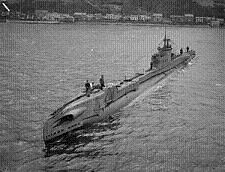
HMS Tudor another Bridgend Adoption
HMS Tudor served in the Far East for much of her
wartime career, where she sank five Japanese sailing vessels, four Japanese
coasters, 4 sea trucks and another Japanese vessel, as well as an unidentified sailing
vessel north of Sumatra. During the War HMS Tudor was adopted by the
Borough of Bridgend as part of Warship Week. The plaque from this
adoption is held by the National Museum of the Royal Navy in Portsmouth, UK.
She survived the war and continued in service with the Navy, finally being
sold to be broken up for scrap on 1st July 1963 when she was scrapped at Faslane.
HMS Tudor
was a British submarine of the third
group of the T class. She was built as P326 at Devonport
Dockyard, Plymouth, UK. She was ordered on the 6th of June 1941, the and
laid down on the 20th September 1941and launched on 23 September 1942, and
commissioned on the 19th of December 1943. On the 16 May 1944
after a period of sea trials and exercises the HMS Tudor with Lt. S.A.
Porter, DSC, RN departed from Holy Loch for Gibraltar. Her orders were to
proceed to Trincomalee to join the Eastern Fleet arriving on the 29 May
1944.
The HMS Tudor was the second submarine to be adopted
by Bridgend, (The HMS Urge being the first.) and has been the only ship
of the Royal Navy to bear the name Tudor, after the Tudor
period.
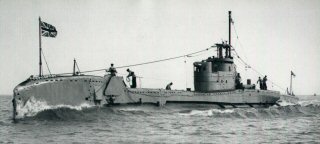
HMS Tudor
HMS Tudor departed Trincomalee for her 1st war patrol on the 6 Aug 1944, to
patrol off the Northern entrance to the Malacca Straits, and to perform a
very special beach landing reconnaissance mission at Bireuen on the
North coast of Sumatra. Which involved the night landing
and recovery of a reconnaissance team on the 17th which lasted 3 hours and
again on the 18th of August, the mission lasted 3.5 hours, with all parties
returned safely.
Whilst patrolling North of Sumatra on the 22nd of August a 120
Foot Junk was spotted that was 3/4 laden and estimated to be around 100
tons. The HMS Tudor broke surface and dispatched the Junk with 4" deck gun fire she
soon sank, the Tudor then dived.
The next day the 23 Aug HMS Tudor again lands a party to make a beach
reconnaissance at Bireuen on the North coast of Sumatra. All the party were
recovered safely early the next morning this successful mission took almost
4 hours. The Tudor ended her 1st war patrol returning to port at Trincomalee
on the 30 Aug 1944.
After a period of rest and the restocking of the submarine the HMS Tudor on
the 19th of September 1944 departed from Trincomalee for her 2nd war
patrol. She was ordered to patrol along the West coast of Siam where
she also had to lay a minefield. On the 24th of September at 2002 hours the
crew laid six mines 600feet apart and 5.5 to 7 Fathoms deep, then at 2310
hours they commenced the second lay of four mines, staggered at 600 feet
apart, in a depth of 7 fathoms, by 2318 hours all ten mines had been laid in
the mine field.
The rest of the 2nd war patrol was uneventful and the
Tudor then returned to port at Trincomalee arriving on the 14th of
October 1944.
Again after resting and restocking of the HMS Tudor, she left port on 2nd of
November 1944 for her 3rd war patrol. With orders to patrol along the West
coast of Sumatra. On the 16th of November 1944 at 0830 hours a vessel was
sighted rounding the buoy off Indrapura point, it was soon identified
as a 150 ton motor ship with the engines and passenger accommodation
aft. It was a Japanese coaster. The HMS Tudor closed to within
2000 yards and surfaced on the starboard quarter of the target, then open
fire with the 4" gun and the Oerlikon. The vessel was hit aft in the engine
room and she stopped with a list to starboard. After 12 rounds 3 other hits
were observed in the hull. All went quiet as a Rufe floatplane was
heard coming down the coast from the North. It was not seen for a while due
to the low cloud but could be heard. The HMS Tudor dived to 48 feet,
and waited as three bombs were dropped by the aircraft. The first was a
close call sending a shuddering through the hull doing some damage to
several gauges. Returning to periscope depth the target could be seen
aground with the stern still in the water so Lt. Porter decided to
fire a torpedo to finish it off. The HMS Tudor fired one torpedo from 2000
yards, but after an initial swerve off course the torpedo exploded
prematurely after running for only 400 yards. It was then that a patrolling
aircraft was spotted. The Tudor dived. After it had left the area the tudor closed in on
the target again and surfaced at 2000 yards, and opened fire with the 4"
deck gun
and the Oerlikon on the beached vessel. Scoring 8 hits with the 4"
gun on
the vessel. It was now well on fire and a total loss to the enemy. At 1745
hours ceased fire and dived, making a course out to sea. She arrived back at Trincomalee on the 26th November which ended her 3rd war patrol.
On the 15th of December the Tudor sailed out of Trincomalee for her 4th war
patrol, with orders to patrol along the coast of Burma. A sailing vessel was
sighted on the 22nd of December it was a two mast schooner that was
Northbound, staying submerged the Tudor closed in on its pray, as the Tudor
was about to surface the vessel anchored off the coast and lowered it sails.
It was of similar built to a Chinese timber tongkang.
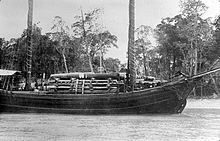
Chinese timber tongkang
The Tutor surfaced and opened fire with the 4"gun at a range of 1300
yards and struck the craft with the 3rd round, they then paused to allow the
crew to abandon ship, which they did not do. Unable to wait any longer in
shallow water the shelling continued until the ship blew up with a
tremendous explosion, judging by the explosion, smoke and the flames it was
judged to have probably been carrying a cargo of cased petrol. Satisfied the
target was totally destroyed the Tudor dived and made for safety in deeper
waters. Two days later in the early morning a 70 ton schooner rigged
tongkang was sighted and a smaller two masted junk some 25 tons, both craft
were deep in the water. The Tudor closed on the schooner still submerged to
attack with gun action, on surfacing opened fire hitting with all five
rounds of 4" the schooner exploded and sank to the bottom. The junk had
anchored just of the shore and the crew had made it to the beach in a
sampan, the Tudor opened fire with 18 rounds of 4" and the junk exploded, both
craft were carrying ammunition.
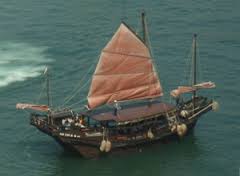
Two masted Junk
Christmas day 0845 hours still submerged the Tudor closed in on a 15
ton two masted junk heading North it was deep in the water, when in range
the submarine surfaced and fired a warning shot from the 4" deck gun, but
the crew did not abandon ship. The Tudor continued to fire, just thee rounds
off and the junk wend down bow first, there was no explosion.
Leaving the scene the Tudor submerged and set a course to the eastward in
search of a new quarry. Just two hours later a schooner was
sighted to the East, this to was Northbound. Staying submerged
the Tudor closed in on its prey, at 1200 hours the submarine surfaced
and fired a warning shot across the bow. The crew of the
schooner took no action. So the firing continued and 11 shells found their
target, the vessel sank rapidly. The Tudor withdrew from the scene and
dived, setting a course Westward.
Whilst still patrolling off the west coast of Burma on the 27th of December
another deeply laden two masted schooner was sighted heading northward.
After closing in on it's target submerged the Tudor surfaced and
opened fire with the 4" deck gun, 14 rounds found their target and the
schooner sank, the action only lasted 40 minutes. The submarine dived
and proceed Southward.
Sailing off the coast on the 29th they sighted a large junk with three masts,
heading North. The vessel was 100 tons and it was flying the
Japanese flag. Surfacing at 1500 yards the
Tudor opened up with the 4" deck gun, nine rounds were fired, and all struck home.
The junk sank beneath the waves in just 2.5 minutes. Submerging
after another successful engagement the HMS Tudor
headed Southward. The rest of the patrol was uneventful and the
HMS Tudor ended her 4th war patrol on the 5th of January 1945 at Trincomalee.
On the 30th of January 1945 after the crew had rested and the ship
restocking the HMS Tudor still under the command of Lt. S.A.
Porter, DSC, RN departed from Trincomalee for the 2 week journey to
Fremantle, Australia, arriving on time on the 13th of February.
In the early morning the HMS Tudor left the port of Fremantle on her
5th war patrol on the 7th of March 1945 with orders to patrol in the
Southern part of the South China Sea.
All was quiet until around mid day on the 22nd of March when smoke was
sighted on the horizon to the South East. The Tudor closed in at speed
and eyeing its target released 4 torpedoes at a 1400 ton merchant ship. The
Tudor then dived into much deeper water and turned South immediately after
firing. All of the 4 torpedoes missed
their targets. There were 2 escort ships, the leading escort soon gained
contact with the Tudor, going right overhead without
dropping any depth charges, despite a firm contact. The escort turned
about for a second run at the Tudor, 7 depth charges were dropped but these
were not close enough to do any damage. A while later 8 more depth charges
were dropped but none of these came deep enough. Tudor turned to
the South-West to keep end on and gain much deeper water. After hearing
nothing for over an hour she returned to periscope depth. Tudor
was detected right away as she came from the depths. The escorts were
obviously still there. Tudor returned to 110 feet and altered
course to the Westward. The escorts passed overhead several times but did
not drop anything. She came to periscope depth but nothing was in sight, so
a course was set for the channel south of Great Natuna Island hoping for
better luck the following day.
On the 23rd of March Tudor sighted the convoy she had unsuccessfully
attacked the day before, the attack is set up but is spoiled as the American
submarine USS Boarfish, which is also on the scene and is detected by
one of the escorts and attacked by the two escorts unsuccessfully
dropping 13 depth charges on her. The convoy again changes course. The rest
of the patrol was uneventful and ended her 5th patrol at Fremantle on 15th
of April.
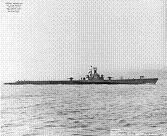
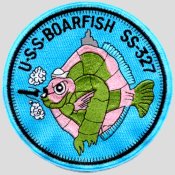
USS Boarfish and Patch
The Tudor's 6th war patrol was in
the
Eastern part of the Java Sea starting on the 7th of May and ended on the
10th of June and was uneventful.
The 29th of June 1945 saw HMS Tudor
departed from Fremantle for her 7th war patrol. She has orders to patrol in
the Java Sea. This would be her last patrol before returning to the U.K. for
a refit.
A schooner of about 150 tons was sighted on the 23rd of July, she was deeply
laden with oil drums stacked on the upper deck and heading east. The Tudor
closed in submerged and surfaced when in range, and fired a warning shots
across the bow, after a short while the crew abandoned the Schooner in a
small boat. The Tudor commenced firing with the 4" deck gun until the
schooner sank. The Tudor then dived to resumed patrol Northward.
Five days later two sea trucks of about 250 tons each were sighted West
bound, there was no escort or air cover. The Tudor closed in for the attack
submerged, then surfaced and engaged the front sea truck which turned
towards the beach, the second sea truck was then engaged and it to turned
toward the beach, both craft eventually beached and were abandoned by their
crews. The Tudor fired 113 rounds of 4" at the targets and both vessels took
many hits. The Tudor turned seaward and dived.

Japanese Sea Trucks 1945
Early the next day they sighted a sea truck on the beach at Pekalongan. The
Tudor moved in, surfaced at 4500 yards and opened fire with the 4" deck gun.
Another laden sea truck of about 250
tons was spotted 4 nautical miles to the West and Eastbound. The Tudor
ceased fire and gave chase, the crew of the sea truck saw them and headed
towards the beach. The Tudor opened fire at 4000 yards with the 4" deck gun
as the craft beached, the crew abandoned the vessel, 70 rounds were fired
with over 30 hits and the craft blew up with a spectacular
explosion throwing debris high into the air. Broke off action and dived
setting a course seaward. On the 11th of
August she ended her 7th war patrol.
On the 22nd of August 1945 the HMS Tudor slipped its mooring in Fremantle
bound for the UK where she is to undergo a refit, calling at Aden, Suez,
Port Said, Gibraltar, Portsmouth then Devonport Dockyard on 23rd October
where she was to undergo a refit.
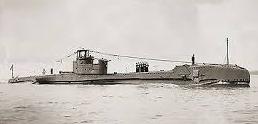
HMS Tudor
Porthcawl Museum
In the old Police Station
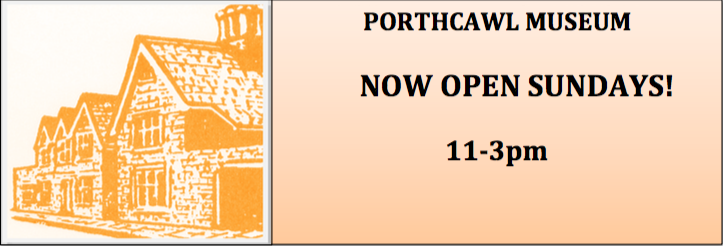
Advertisements
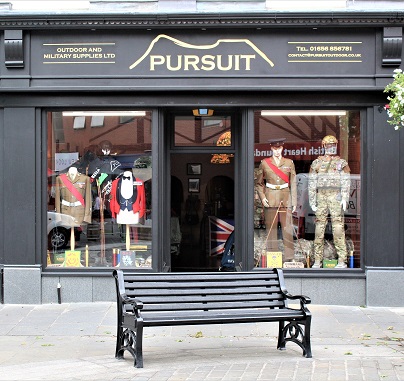
42 Dunraven Place, Bridgend
Contact: Mike 07840 287 383
web site here
Share with your friends on Facebook or Twitter. Just Click the link below.
 Facebook
Facebook
 Twitter
Twitter
Return to Main
Bridgend History Page
Copyright BridgendPPF.com 2017



 Bridgend
the town by the river
Bridgend
the town by the river 









